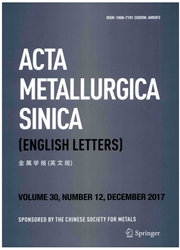

 中文摘要:
中文摘要:
热的不同分区的微结构特征影响了低焊接的地区(HAZ ) 裂缝危险性钢焊接被使用光显微镜学并且扫描与电子 backscattered 衍射装备的电子显微镜学调查系统。并且焦点被放在在微结构特征和焊接的 HAZ 坚韧之间的关联上。结果表明熔化的坚韧衬里地区(FLZ ) 标本比精细的 HAZ (FGHAZ ) 标本的低得多。在焊接金属的粗糙的包括和在粗糙的颗粒的 HAZ (CGHAZ ) 的大马氏体奥氏体成分在 FLZ 的裂缝开始精力上有明显的否定效果。同时,有大有效谷物的粗糙的小粒的 bainite 减少裂缝繁殖精力严重。由对比,在 FGHAZ 的好结晶的谷物在增加坚韧起一个关键作用,特别在改进裂缝繁殖精力。
 英文摘要:
英文摘要:
Microstructural characteristics of different sub-regions of heat affected zone (HAZ) of low welding crack susceptibility steel weldment were investigated by using optical microscopy and scanning electron microscopy equipped with electron backscattered diffraction system. And the focus was put on the correlation between microstructural characteristics and HAZ toughness of the weldment. The results reveal that the toughness of fusion line zone (FLZ) specimens is much lower than that of fine grained HAZ (FGHAZ) specimens. The coarse inclusions in the weld metal and the large martensite-austenite constituents in the coarse grained HAZ (CGHAZ) have an obvious negative effect on the crack initiation energy of FLZ. Meanwhile, the coarse granular bainite with large effective grain decreases the crack propagation energy seriously. By contrast, fine crystallographic grains in the FGHAZ play a key role in increasing toughness, especially in improving crack propagation energy.
 同期刊论文项目
同期刊论文项目
 同项目期刊论文
同项目期刊论文
 Microstructural evolution and toughness in the HAZ of submerged arc welded low welding crack suscept
Microstructural evolution and toughness in the HAZ of submerged arc welded low welding crack suscept Effect of single pass welding heat input on microstructure and hardness of submerged arc welded high
Effect of single pass welding heat input on microstructure and hardness of submerged arc welded high Effect of austenite grain size on isothermal bainite transformation in low carbon microalloyed steel
Effect of austenite grain size on isothermal bainite transformation in low carbon microalloyed steel Analysis of martensite-austenite constituent and its effect on toughness in submerged arc welded joi
Analysis of martensite-austenite constituent and its effect on toughness in submerged arc welded joi Analysis of microstructural variation and mechanical behaviors in submerged arc welded joint of high
Analysis of microstructural variation and mechanical behaviors in submerged arc welded joint of high Toughness of welding heat affected zone in high strength steel with low welding crack susceptibility
Toughness of welding heat affected zone in high strength steel with low welding crack susceptibility Effect of reheat temperature on continuous cooling bainite transformation behavior in low carbon mic
Effect of reheat temperature on continuous cooling bainite transformation behavior in low carbon mic Limit load analysis of simply supported circular plate under partial uniformly distributed load with
Limit load analysis of simply supported circular plate under partial uniformly distributed load with Analytical solution of plastic limit load for simply supported circular plate under uniformly distri
Analytical solution of plastic limit load for simply supported circular plate under uniformly distri Structure and micromechanical properties of a weld joint using steel with low sensitivity to weld cr
Structure and micromechanical properties of a weld joint using steel with low sensitivity to weld cr Analysis of the hardness and elastic modulus distribution in a high strength steel welded joint by n
Analysis of the hardness and elastic modulus distribution in a high strength steel welded joint by n Continuous cooling temperature field for plate after rolling during fully developed regime by variat
Continuous cooling temperature field for plate after rolling during fully developed regime by variat The formation of acicular ferrite and mechanical properties behaviors in a low welding crack suscept
The formation of acicular ferrite and mechanical properties behaviors in a low welding crack suscept Study on machinability and polishing performance of 1CrMn2MoVTiB non-quenched and tempered plastic m
Study on machinability and polishing performance of 1CrMn2MoVTiB non-quenched and tempered plastic m Variational solution of continuous cooling temperature field for plate after rolling during fully de
Variational solution of continuous cooling temperature field for plate after rolling during fully de The calculation of roll torque and roll separating force for broadside rolling by stream function me
The calculation of roll torque and roll separating force for broadside rolling by stream function me Effect of boron addition on the microstructures and mechanical properties of thermomechanically proc
Effect of boron addition on the microstructures and mechanical properties of thermomechanically proc Analysis of die drawing of round bar and wire in cylindrical coordinate by inner-product of strain r
Analysis of die drawing of round bar and wire in cylindrical coordinate by inner-product of strain r Limit load analysis of simply supported circular plate under linearly and uniformly distributed load
Limit load analysis of simply supported circular plate under linearly and uniformly distributed load 期刊信息
期刊信息
